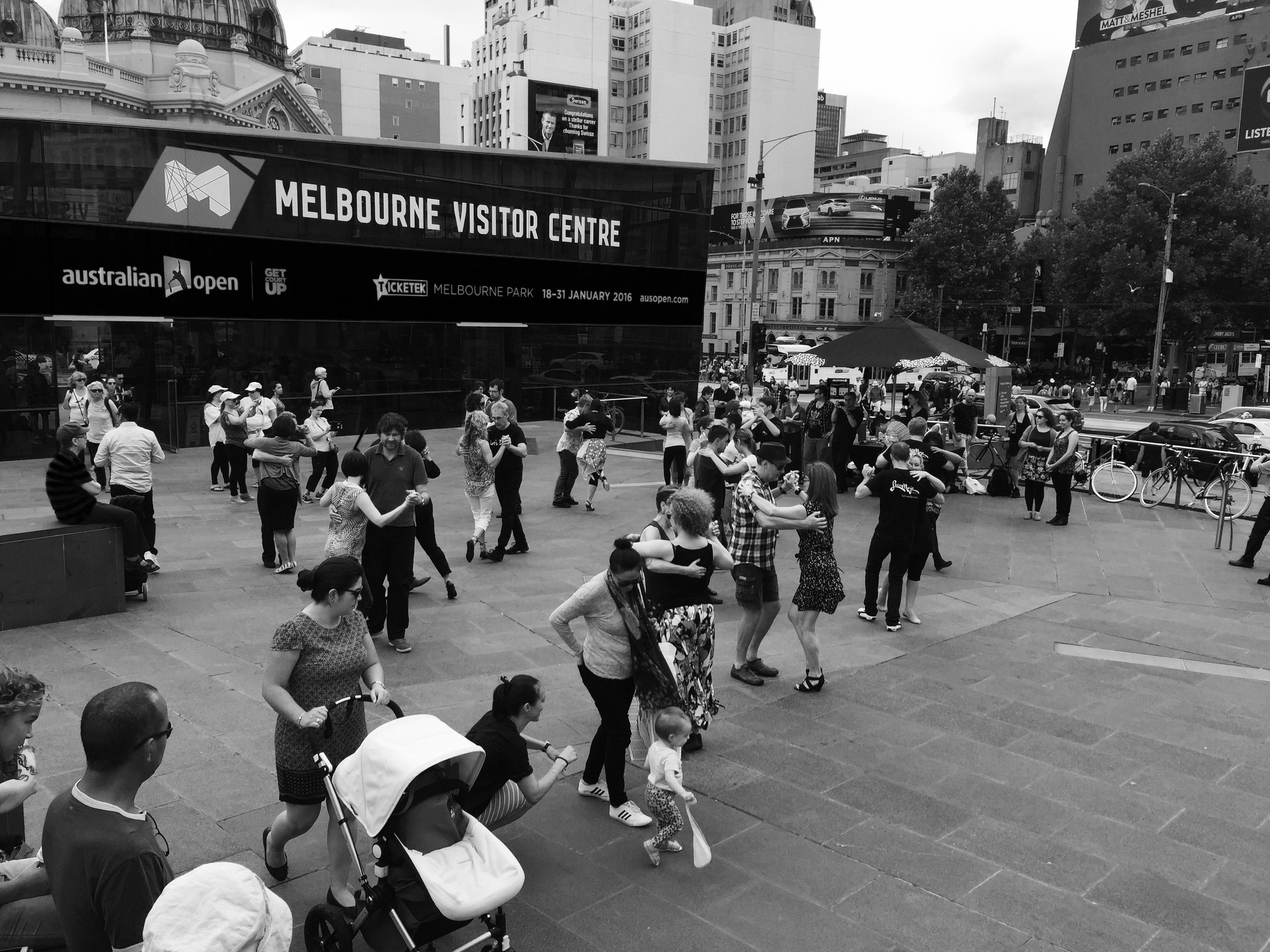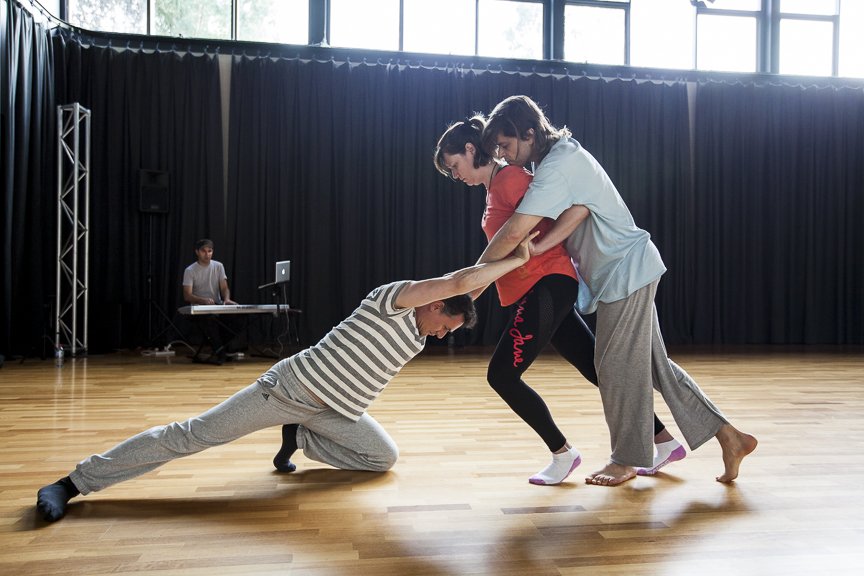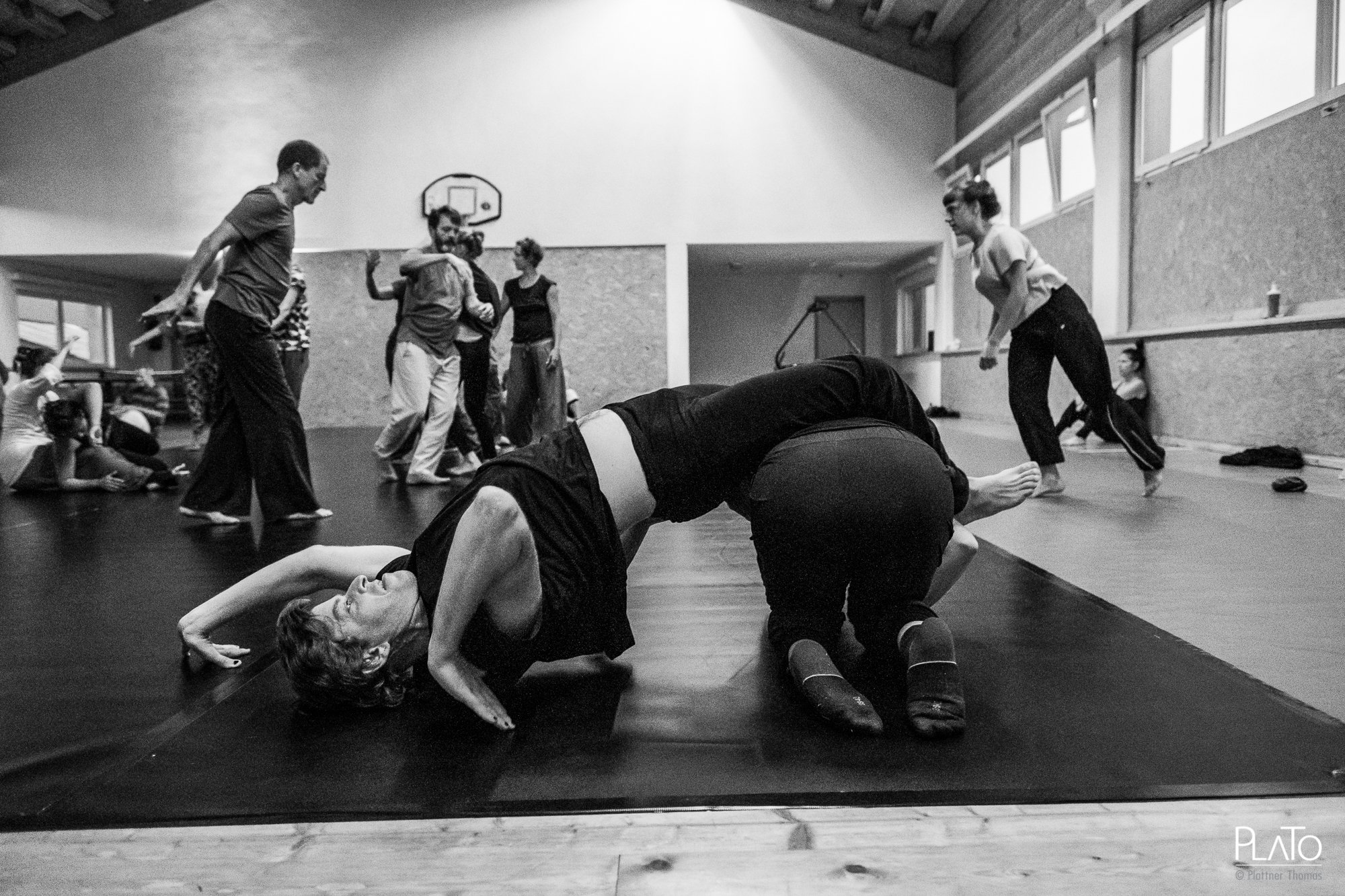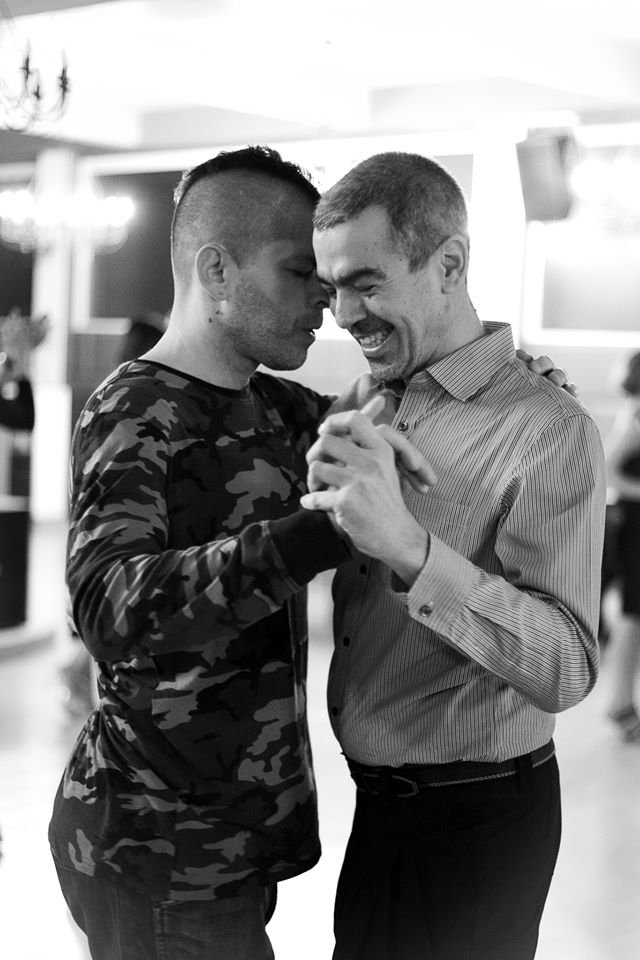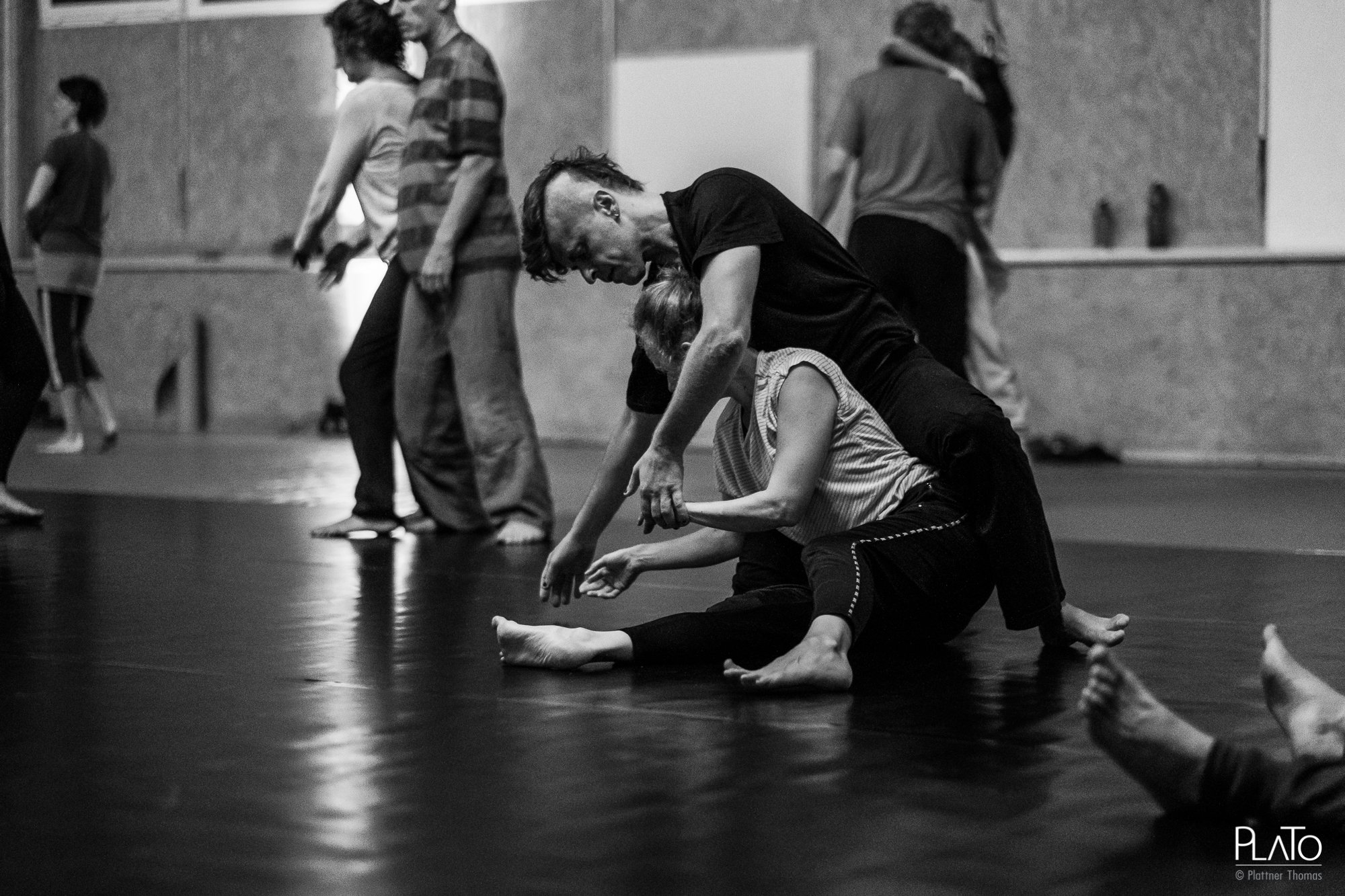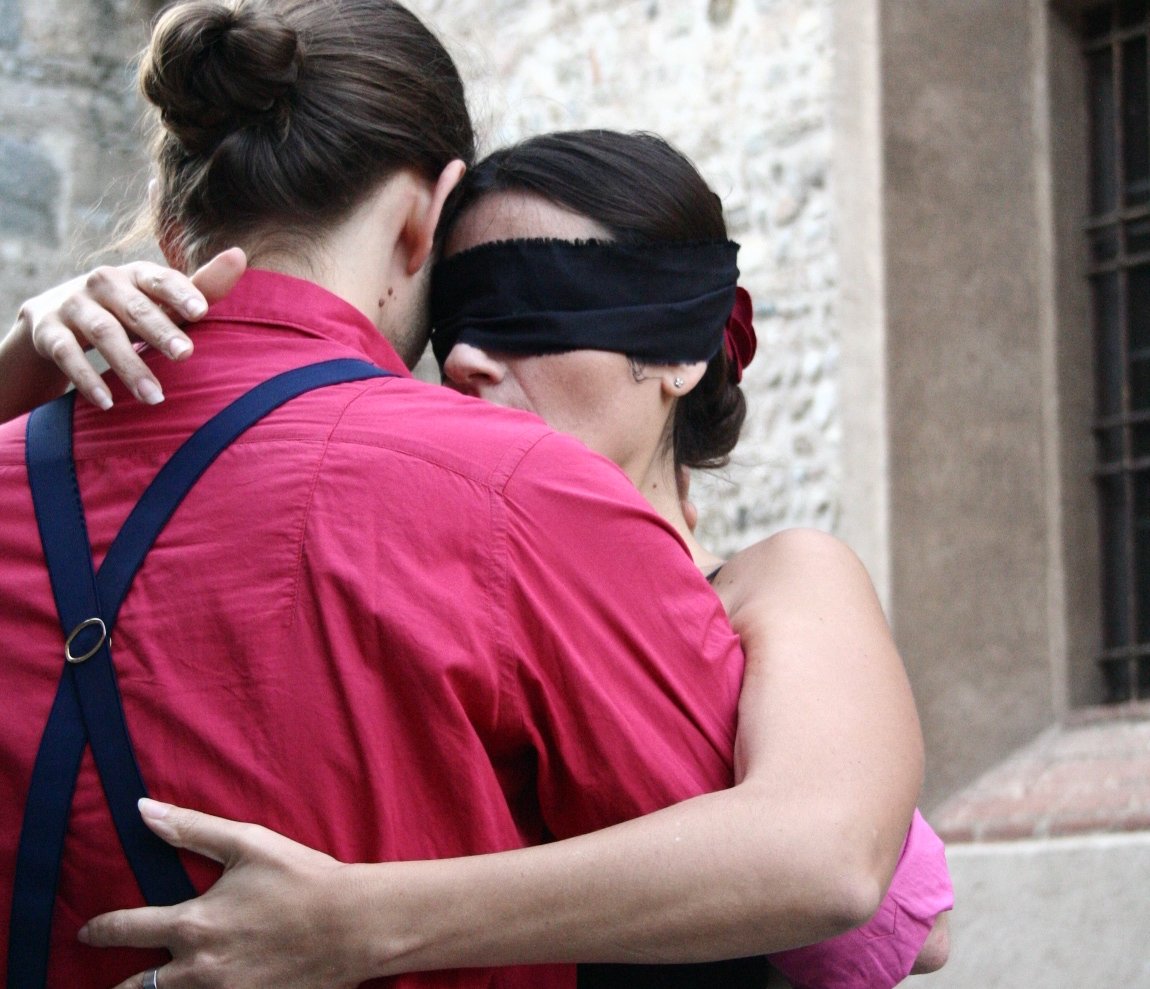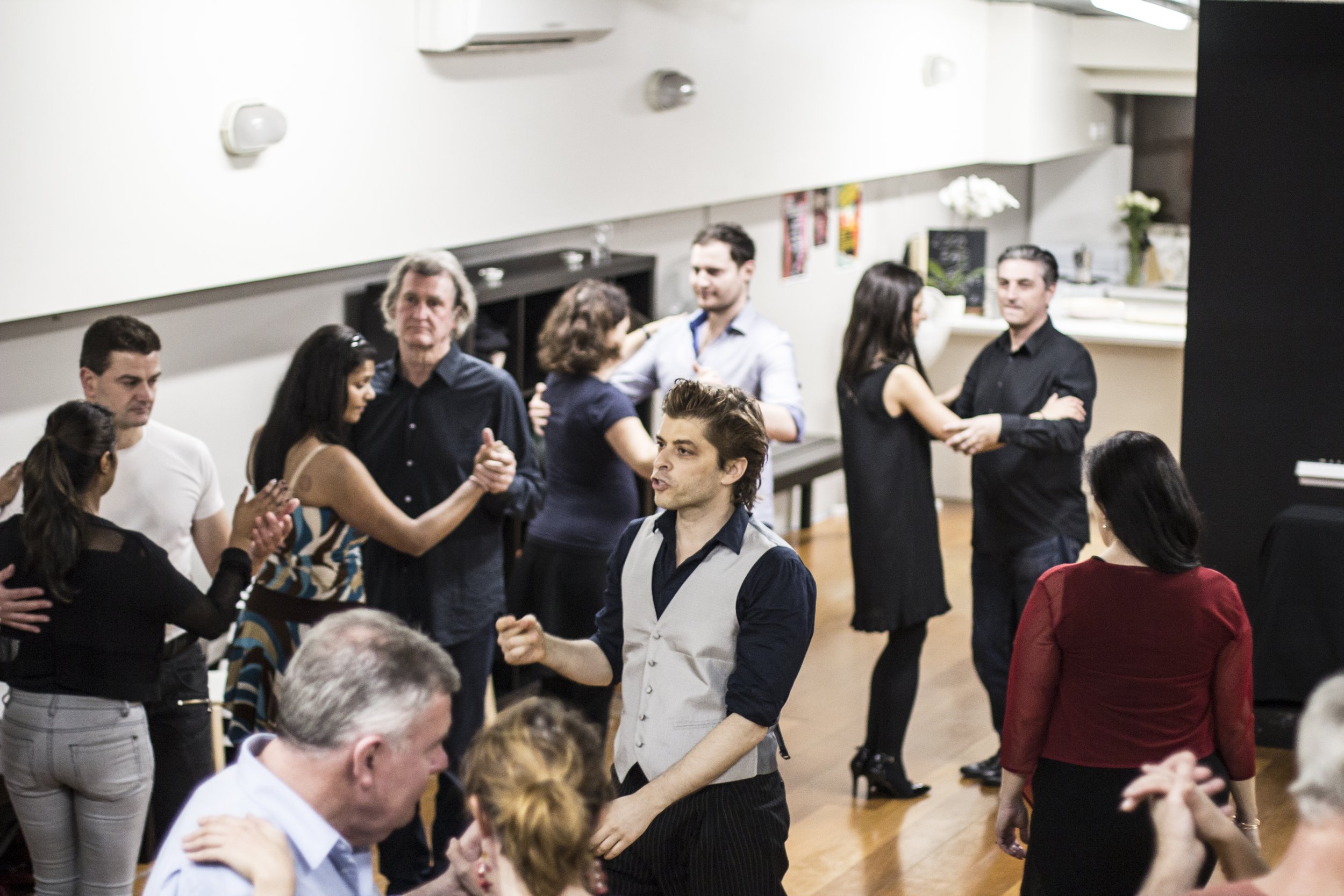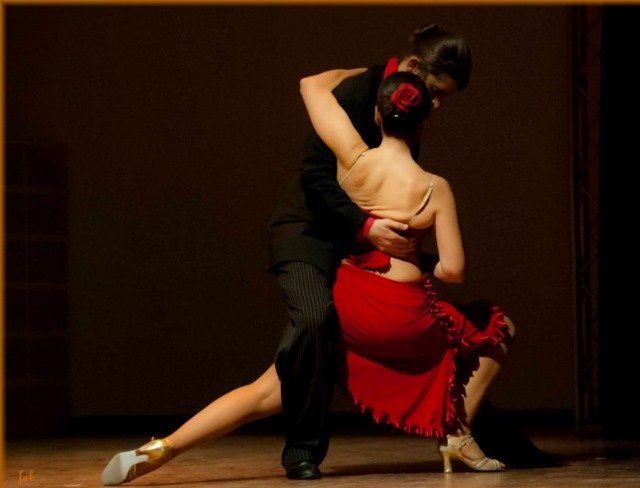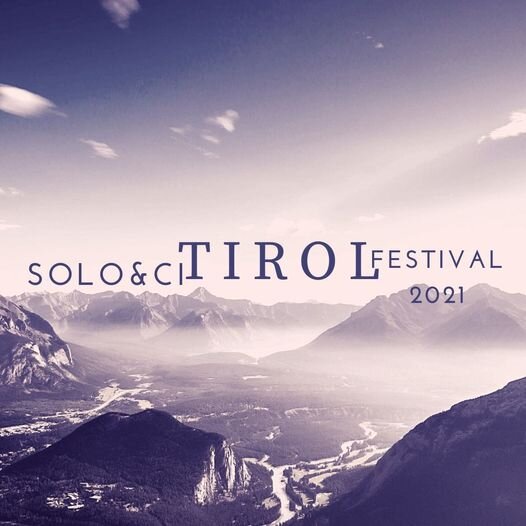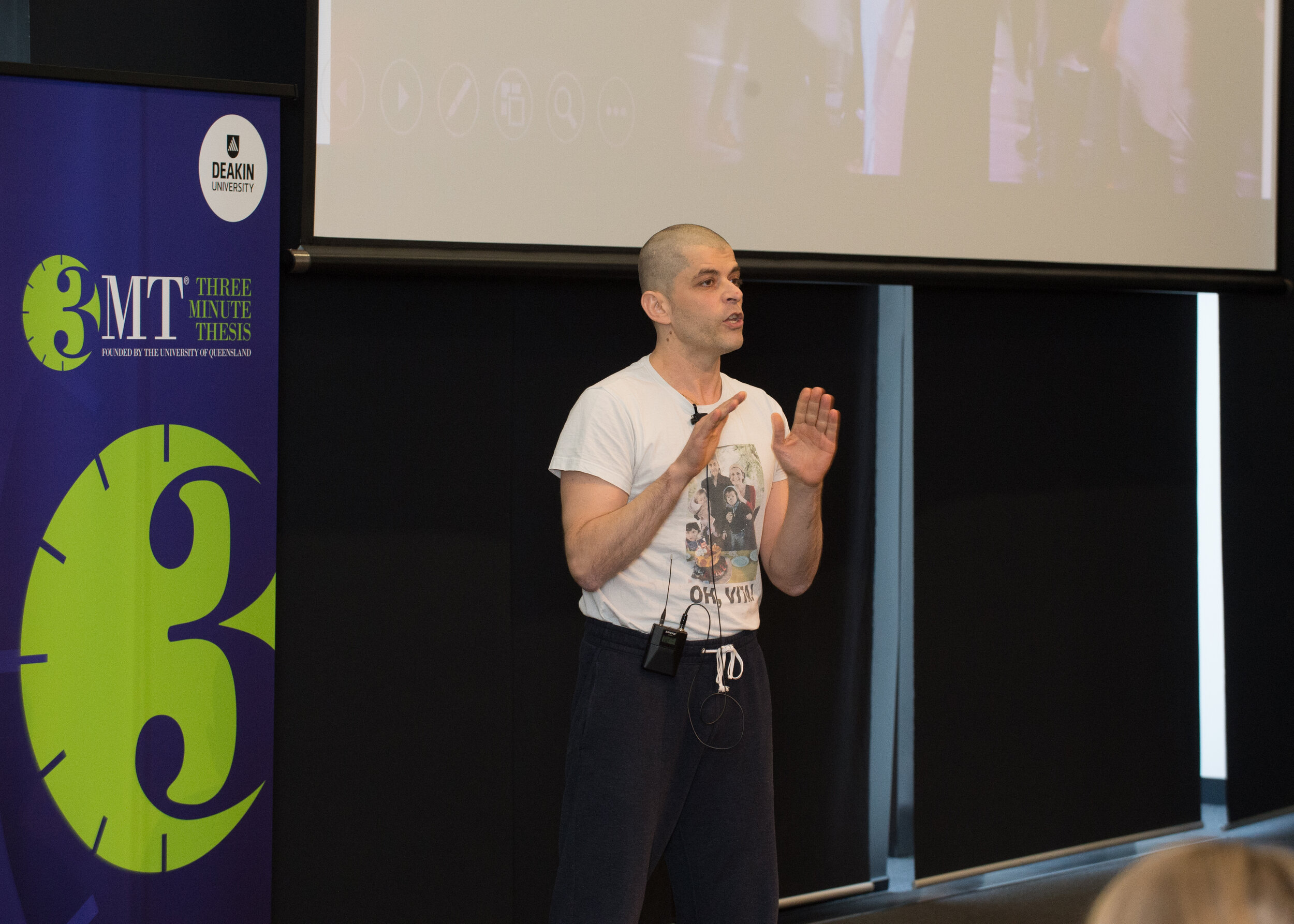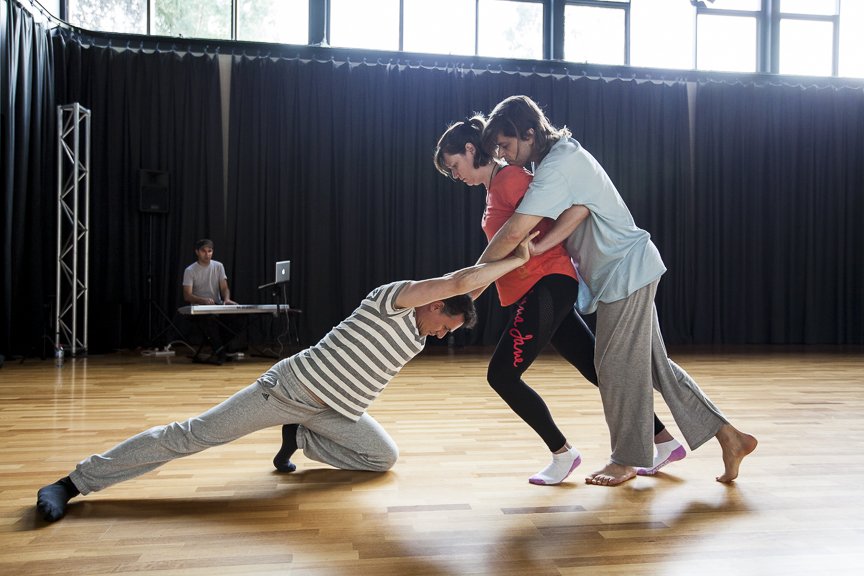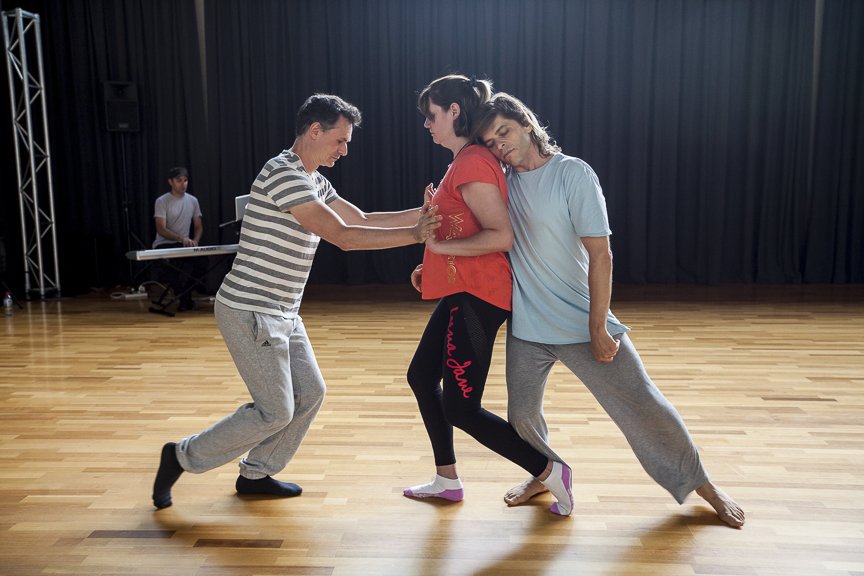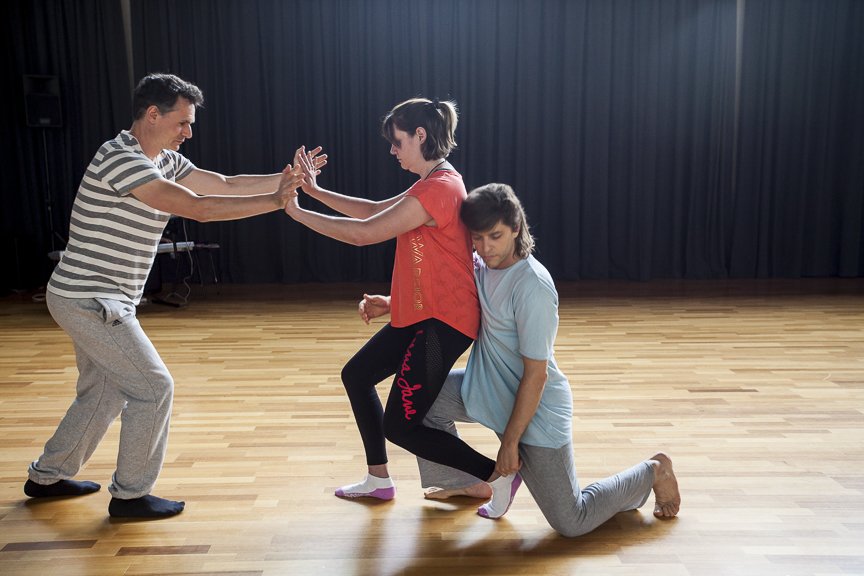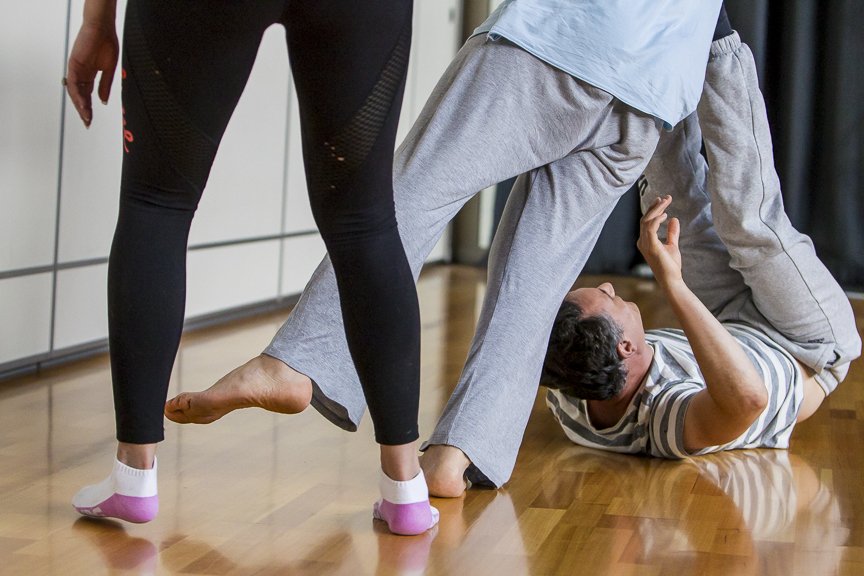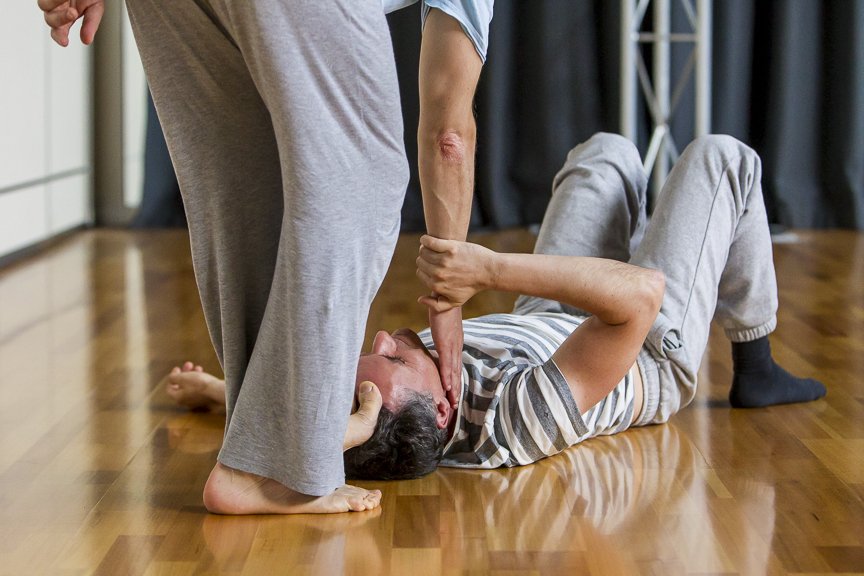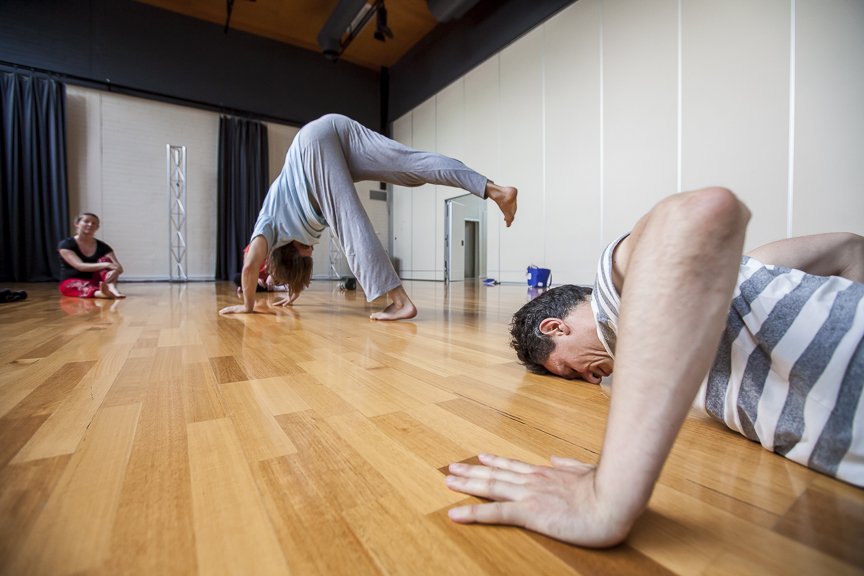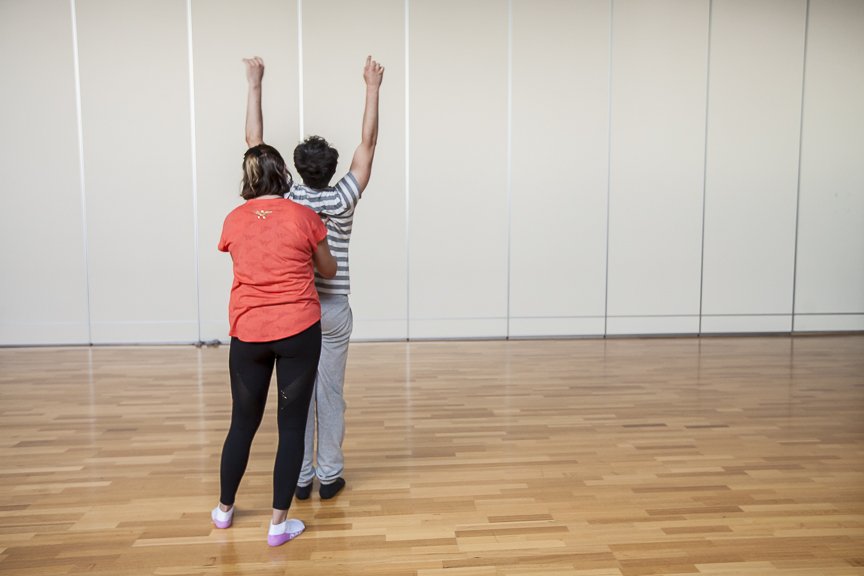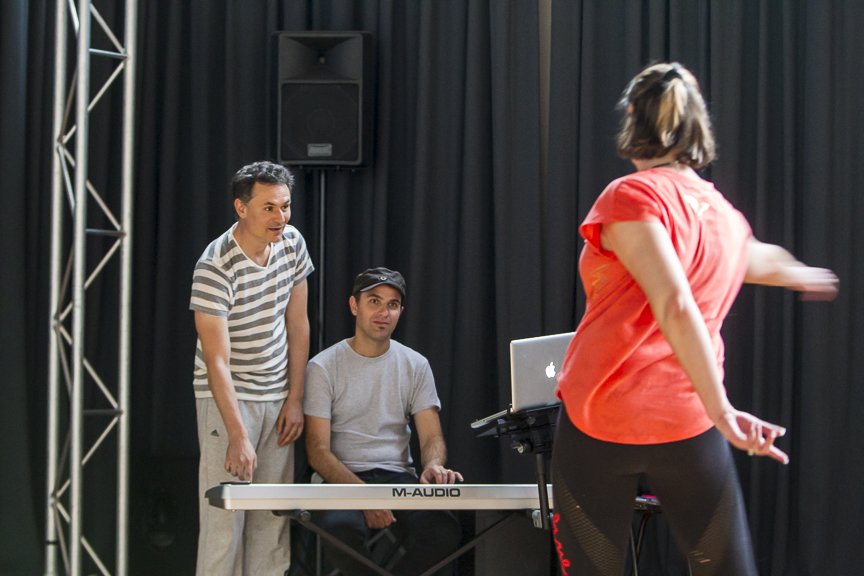Tango-Contact
Touch in Tango and Contact Improvisation: A practice of co-liberation?
Through dancing, teaching and performing tango and contact improvisation for nearly fifteen years, mainly in Milan, Melbourne and Rome, I have developed a desire to understand how it is that, within the traditional framework of the milonga (the key tango social gathering), tango allows the partners (who are likely never to have met each other before) to indulge in a deep, sensuous and long-lasting experience of touch. At the most basic level, dancing tango involves two people, embracing each other, sharing weight and often also the centre of gravity, and moving together around the dance-floor in a highly interdependent way following the rhythm of the music and taking into consideration the movement of other couples. Tango dancers are literally dancing heart-to-heart and they can hear the breath of the other. They can become immersed in the dance to the point of closing their eyes.
Upcoming events:
IMPULS TANGO INNSBRUCK, International Tango Workshop Weekend + Practica, Sunday 21 April 2024, 16-22h, Jugendheim Saggen. Registrations are open.
CONTACT MEETS TANGO INNSBRUCK, International Tango Workshop Weekend + Jam, Saturday 20 April 2024, 16-22h, Jugendheim Saggen. Registrations are open.
Current and Recent Projects
SOMATICS INTO TANGO: Four Workshops on Dance Awareness (Festival Tango Contamination, Maison du Mouvement, Strasbourg, 2022)
CONTACTANGO WEEKEND: Intensive Workshops (Motion Mode Theatre, Innsbruck, 2021)
CONTACT MEETS TANGO: Being Danced by Another (Solo and Contact Improvisation Tirol Festival, 2021)
RE-ENGAGING TOUCH IN TANGO: Practice-led PhD Research (Deakin University Melbourne 2016-2020)
TANGO CHILLOUT: Social dance practice at Oussou Bar (Melbourne, 2015-2017)
YOUTH TANGO PROGRAM: Dance, expression and relationality (Milan, 2012-2013)
Contact-Tango, Solo and Contact Improv Tirol Festival 2021
Dancing Tango is conducive to a state of feeling together and to be reached and changed by the impulses, sensations and feelings of the other dancer. This perceptual shift is pursued by engaging with a unique kinesthetic framework that, out of an infinite number of possible sensory stimulations and impulses, enables the dancers to feel physically and affectively present. On the one hand, these are moments one could not experience without the form of the dance. On the other, however, this traditional framework narrows the options available for moving together. The partners are bound to a series of assumed dualisms—between genders, roles, styles of music and types of movements. What happens to those kinesthetic feelings and sensations that are dissonant, that do not fit in the shared interpretation and in the accepted sociocultural activations of the form?
“The partners are bound to a series of assumed dualisms—between genders, roles, styles of music and types of movements. What happens to those kinesthetic feelings and sensations that are dissonant, that do not fit in the shared interpretation and in the accepted sociocultural activations of the form?”
Queer Tango, Festival Tango Contamination, Strasbourg 2022
PhD Tango Project at Deakin University Melbourne (2016-2020)
In January 2016 I embarked on a PhD project on touch in Tango at Deakin University Melbourne. To challenge my embodied habits and assumptions as a tango dancer, deepen my sensitivity, expand my vocabulary and develop practical tools of movement inquiry, in 2017 I have approached contact and contemporary modes of dance improvisation. In particular, by leveraging the kinaesthetic tools and the spirit of freedom and emancipation typical of Contact Improvisation, I have explored the fundamentals of Tango not as given techniques or assumptions but as ‘enabling constraints’ to find a deeper sense of freedom and sharing in the dance. Engaging tango through the ‘lens’ of Contact Improvisation allows the dancer to observe and follow movement dynamics as they unfold in the shared improvisational process through the subtle play of touch, pressure and weight. The doctoral research was conducted in public spaces (first phase) and in dance studios (second phase) but I have never stopped dancing Tango and Contact Improvisation socially since the field work began. The PhD, awarded in March 2020, develops an experimental framework for engaging touch in Tango as an experience of kinaesthetic listening. The process of inquiry led me to articulate both practical and conceptual resources for exploring the somatic-imaginative spaces between the dancer’s inside and outside worlds (see my PhD thesis and the article on touch in tango as an experience of kinaesthetic listening I published in the Journal of Dance and Somatic Studies in 2020).
The conversation between tango and contact improvisation in my practice-research has revealed an important insight: the deeper contents and meanings of touch in partnering tend to emerge not when we focus on having to do something, or on having to encounter someone. They emerge when we focus on what happens, and when we wait to be moved by what happens - both physically and affectively. When you dance in physical contact with someone else, the body can reveal a capacity to sense together, to feel together and to be expressive together. I propose that this process of ‘being danced’ by another and by other external impressions can be explored and understood as an experience of ‘kinaesthetic contagion’. Contagion is a word that has become so central in our lives in the light of Covid-19. Although there has always been a negative connotation attached to contagion, we are now facing an attack to the very possibility of imagining that there can also be another side of the coin. Contagion is generally understood as the process by which our bodies carry germs, bacteria and viruses that can infect other bodies through touch. Drawing on the work of Susan Foster (2008), I argue that this understanding can be extended to include the possibility that our sensations and feelings also affect others. When this happens, partner dance can become more powerful than the individual dancers, and something can be revealed about the body, the self, others and the sensuous world that was not previously available to perception (I have published a chapter on this topic in the book collection Thinking Touch in Partnering and Contact Improvisation, edited by Malaika Sarco-Thomas in 2020).
The embodied knowledge of Contact Improvisation is a key to become aware and express the shift from active to passive modes of perceptions in the tango dance (witnessing/witnessed, touching/touched, dancing/danced). In this sense, I approach the interchange between Tango and Contact as a dance-enabled door to the enchantment, the emotion of being the witness of a dance that is more powerful than the individual dancers and of the established form of the dance. This door opens up a space for nurturing and sharing empathy, generosity and responsibility. These qualities are essential for our individual well-being and for our survival as a species.
Tango Improvisation Lab, Melbourne and Sydney 2017-2018
Eros in the Tango Dance
There is another key thread emerging from my practice-research on tango and on the interchange between tango and contact conversation. The dance-enabled experience of allowing each other to be in a carnal and spiritual state of feeling together can be understood and explored as an expanded experience of eros which transcends the cultural reduction of eros to a sexual act. As a tango dancer re-engaging the felt sense of touch—not as obsessional attachment to forms and values but as perceptual channel into the sharing of impulses—I was led to question the implicit assumption that the idea of tango is fundamentally premised on the the fusion of the two halves into the formal perfection of their unison as a couple. This assumption implies one half of the dance (the follower, usually female) surrendering while the other half (usually male) is leading. Approached through the lens of contact, eros in tango emerges as an ongoing negotiation of movement possibilities occurring in the space between the dancers. As an act of listening, giving touch does not involve merely dictating an impulse within the improvisation, while receiving touch is not merely about surrendering one’s impulse to the improvisation. Both acts, both moments of giving and receiving, both roles of leading and following, involve an exchange between the two poles of the tactile-kinesthetic transmission, both in terms of sensations and feelings and of roles and attitudes towards being exposed to the other. What is felt as shared in the transmission between the two poles of the dance is, at the same time, part of one dancer and of the other, while exceeding both of them in the very possibility of incarnation. By experimenting with the unexpected outcomes of their negotiation, the dancers can unlock the potential for supporting each other’s expression and growth. In his attempt to describe the attitude involved in contact improvisation, Steve Paxton (1975) addresses this open-ended exchange as a practice of cooperation: “In learning this form, the partners must break through the concept that the other controls the situation to an appreciation that they each can determine both their own and the other’s options” (p. 41). In my practice-research, the tension between freedom and constraint in the experience of feeling and moving together is understood not only as a process of sharing intentionality (a cooperation with) but also, more importantly, of sharing vulnerability (an exposure to). This realisation calls for an alternative kind of nexus between the longing for a tactile experience of sharing and the irreducible uniqueness each living body brings to the improvisational moment.
The understanding of eros in Tango and Contact as a perceptual negotiation involves the apparently contradictory situation whereby one is at the same time yearning to be connected with and separated from someone else and something else. However, as argued by Irigaray (1996), reading the tension between togetherness and separateness as a contradiction implies a definition of freedom which is premised on the ideal of unity in the first place. My research discovers the possibility of re-encountering the felt sense of touch as a shared sense of freedom and constraint, where freedom is defined as the freedom “to be what or who I am: one half of human kind” (Irigaray, 1996, p. 41). Borrowing Irigaray’s (1992) words, touch as kinesthetic listening emerges as a practice which allows dissonance in the shared improvisation to work as a “motor of becoming” rather than as “the becoming which appropriates the other for itself by consuming it, introjecting it into itself, to the point where the other disappears” (p. 27). From this alternative perspective, eros is understood as a longing for each other’s growth. As the form of the dance ceases to be a fixed goal for me, and as my focus shifts to touch and listening, the other dancer ceases to be an instrument to achieve my freedom and becomes a partner in a somatic practice of co-liberation.
For references and quotes from the text of this page, please cite Raffaele Rufo, 2024, ‘Touch in Tango and Contact Improvisation: A Practice of Co-liberation?’, www.raffaelerufo.com/tango-contact
References
Foster, Susan L. (2008), ‘Movement’s contagion: The kinesthetic impact of performance’, in The Cambridge Companion to Performance Studies (ed. Tracy C. Davis), Cambridge, UK: Cambridge University Press, pp. 46–59.
Irigaray, Luce (1992), Elemental Passions (trans. J Collie & J Still), London: The Athlone Press.
Irigaray, Luce (1996), I Love to You: Sketch for a Felicity within History (trans. A Martin), New York: Routledge.
Paxton, Steve (1975), ‘Contact improvisation’, The Drama Review, 19:1, pp. 40–2.
Rufo, Raffaele (2020a), ‘Re-engaging touch in tango: An experiential framework for kinesthetic listening’, Ph.D. thesis, Melbourne, Australia: Deakin University, School of Communication and Creative Arts, https://www.researchgate.net/publication/339947887_Re-engaging_touch_in_tango_An_experiential_framework_for_kinesthetic_listening.
Rufo, Raffaele (2020b), ‘Touch in tango as a form of contagion’, in Thinking Touch in Partnering and Contact Improvisation: Pedagogy, Philosophy, Practice (ed. Malaika Sarco-Thomas), Newcastle upon Tyne, UK: Cambridge Scholars Publishing, pp. 129–48, https://www.researchgate.net/publication/346488001_Touch_in_Tango_as_a_Form_of_Contagion.
Rufo, Raffaele (2020c), ‘(Re-)engaging touch as a tango dancer: An experimental framework for kinaesthetic listening’, Journal of Dance & Somatic Practices, 12:2, pp. 207–228, https://www.researchgate.net/publication/347991741_Re-engaging_touch_as_a_tango_dancer_An_experimental_framework_for_kinaesthetic_listening.
